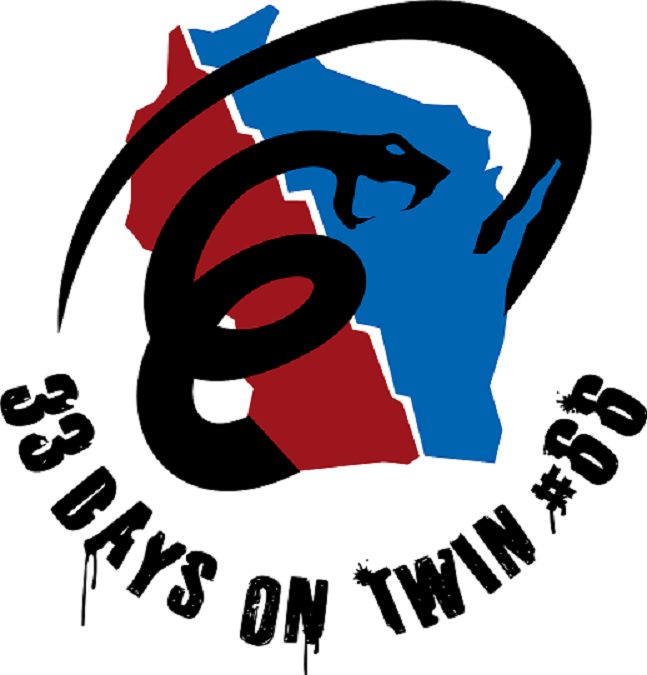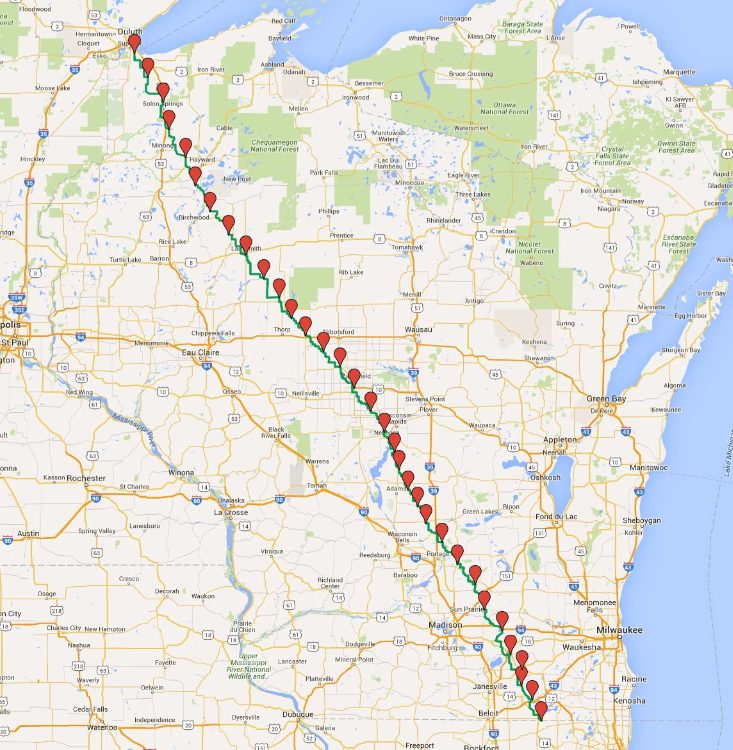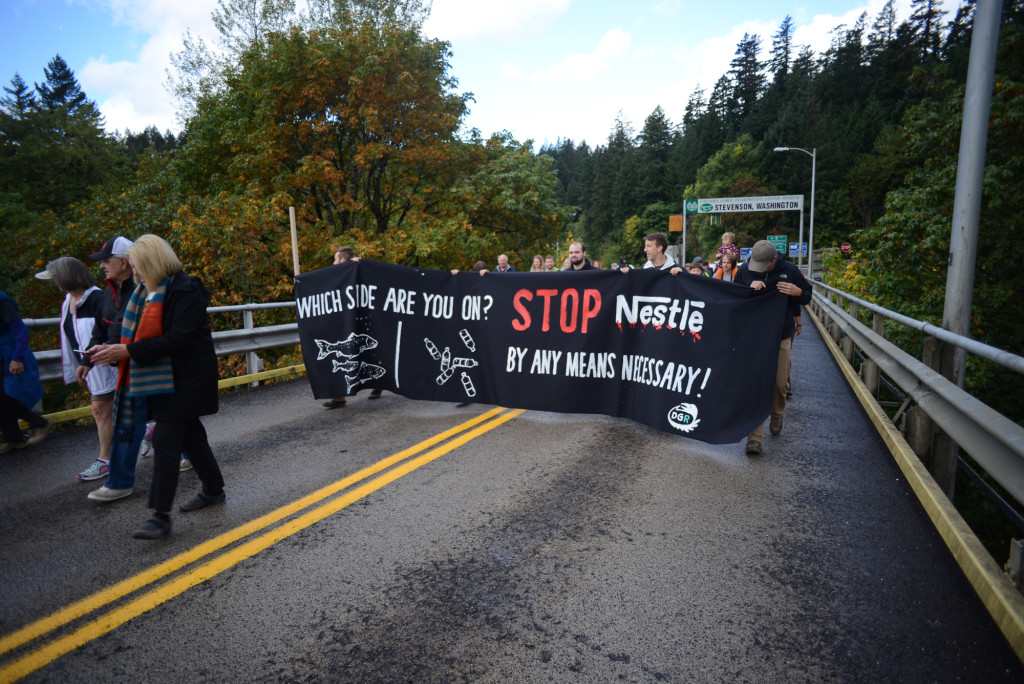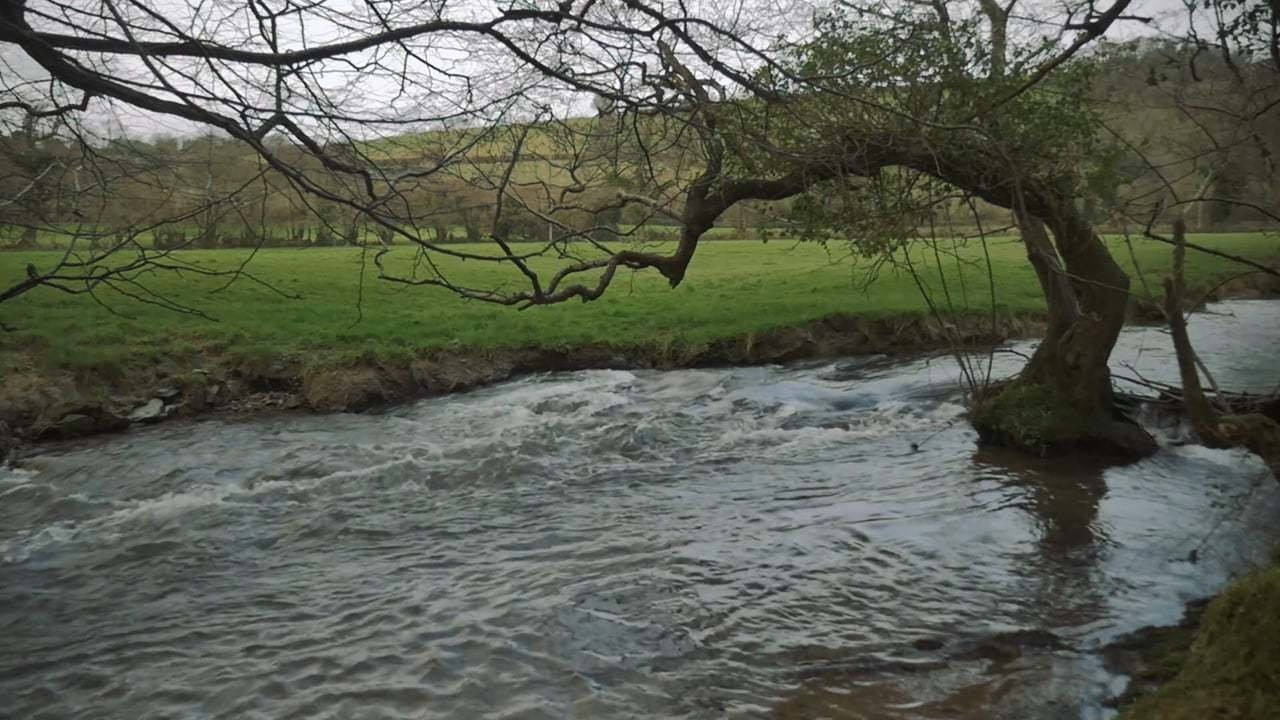
by Deep Green Resistance News Service | Aug 27, 2016 | Obstruction & Occupation
By Deep Green Resistance Seattle
A coal train entering Bellingham, Washington has been blockaded by a fossil fuel resistance group, including members of Deep Green Resistance. This blockade, part of an ongoing regional campaign against fossil fuels, has been standing strong for six hours – with no end in sight.
Beginning at four PM this afternoon, protestors erected a portable tripod structure in the middle of a rail bridge crossing Mud Bay south of Bellingham. One protester has climbed to the top and will stay until removed by police.
The organizers of the blockade say that fossil fuels must be stopped to save the planet from global warming.
When asked about her motivation for joining the resistance movement, one Deep Green Resistance member responded, “We won’t be complicit in a global catastrophe. The government and the capitalists are working together to kill the planet. We’re going to work together to stop them.”
With two refineries sitting north of town and a tar sands pipeline running underneath, Bellingham has been in the sights of the fossil fuel industry for decades. The struggle to keep fossil fuel transportation out of the small city has been ongoing. The Lummi Nation and other local resisters recently defeated plans for a major coal export terminal. However, coal merchants continue to push for the project.
The protest also delayed passenger trains, but organizers aren’t overly concerned. When asked about possible inconveniences to travelers, a protestor responded, “What’s inconvenient is losing your island to rising sea levels, or having your home flooded in Baton Rouge, or digging mass graves in Pakistan in anticipation of heat waves.” She also noted that Amtrak was notified to minimize delays in passenger transportation.
From Deep Green Resistance Seattle: http://deepgreenresistanceseattle.org/resistance/direct-action/activists-stage-coal-train-blockade-bellingham-train-stopped-5-hours-counting/

by Deep Green Resistance News Service | May 22, 2016 | ACTION, Protests & Symbolic Acts
By Sacred Water Sacred Land
Sacred Water Sacred Land is sponsoring a tar sands awareness walk through Wisconsin along Enbridge’s proposed Twin Line #66 starting with a kick-off event in Delevan or Walworth on June 8th.
33 Days on Twin #66, a Sacred Water Sacred Land sponsored walk, begins at the entry point of the Enbridge pipeline system, just south of Walworth, WI and follows the route northwest to Superior, raising awareness about the existence of, and proposed expansion to, the Enbridge crude and dilbit pipeline corridor along the way.
33 Days on Twin#66 will consist of consecutive daily 10-15 mile segments with community engagement talks in a revival type setting at overnight encampments at many points along the way. The 420-mile pipeline route is broken into four major sections: northern, upper central, lower central and lower.
Winona La Duke, who has fought tirelessly against the Sandpiper expansion in Minnesota, and her sister Lorna, will be riding with us on horseback along several sections of the walk.
Affected communities and landowners will be engaged by representatives of SWSL – Sacred Water Sacred Land, CELDF – Community Environmental Defense Fund, and WiSE – Wisconsin Safe Energy Alliance, through an ecological forum where the impact of the expansion and a broader conversation about the adverse effects of Canadian tar sands extraction and transport will be explained. Guest speakers will also address climate change and traditional ties to the land while local residents will be encouraged to share their stories and efforts towards healing it.
Through this effort, SWSL endeavors to not only draw attention to the tremendous hazards of tar sands/Bakken oil transport but also help communities imagine and co-create a more sustainable, health conscious society with an emphasis on renewables and non-toxic food systems.
We are looking for additional sponsors to lend credence and build support for the Walk. Sponsorship is welcome in many forms. We encourage you to share the Walk with your membership and follow us on Facebook where specific details will be posted as they solidify. If you wish to participate in greater measure, please contact SWSL directly.
It is past time to unify our efforts and promulgate ecological systems literacy. We hope you will join us as we work together towards a paradigm shift of social and environmental justice for the natural world and the next seven generations.
Cosponsored by WiSE, CELDF, and SWSL

Schedule:
1 ~ June 8th – Walworth*, Kick-off!
2 ~ June 9th – Delavan*
3 ~ June 10th – Richmond
4 ~ June 11th – Whitewater*
5 ~ June 12th – Fort Atkinson*
6 ~ June 13th – Lake Mills*
7 ~ June 14th – Sun Prairie*
8 ~ June 15th – Columbus*
9 ~ June 16th – Wyocena
10 ~ June 17th -Portage*
11 ~ June 18th – Oxford*
12 ~ June 19th -Westfield
13 ~ June 2oth – Adams/Friendship*
14 ~ June 21st – Cottonville
15~ June 22nd – Lake Arrowhead
16 ~ June 23rd – Nekoosa*
17 ~ June 24th – Vesper
18 ~ June 25th – Marshfield*
19 ~ June 26th – Spencer
20 ~ June 27th – Riplinger
21 ~ June 28th – Owen/Withee*
22 ~ June 29th – Lublin
23 ~ July 30th – Gilman
24 ~ July 1st – Sheldon
25 ~ July 2nd – Ladysmith*
26 ~ July 3rd – Imalone
27 ~ July 4th – Meteor
28 ~ July 5th – Hauer-Stone Lake
29 ~ July 6th – Hayward
30 ~ July 7th – Gordon*
31 ~ July 8th – Salon Springs
32 ~ July 9th – Hillcrest
33 ~ July 10th – Superior*, Renewable Energy Independence Day!
* Denotes Revival

by Deep Green Resistance News Service | Feb 18, 2016 | Biodiversity & Habitat Destruction
By Deep Green Resistance
Wild Bison are an icon of what has been destroyed by civilization, and this species is now on the brink in the wild. Almost all bison left today are cross-breeds held in confinement. There are only a few wild, free ranging bison herds left on the planet, and their numbers are small. Every year, the Park Service — at the behest of ranchers — round up, quarantine, harass, and kill many of the wild bison who live in and around Yellowstone National Park. We stand with grassroots land defenders such as the Buffalo Field Campaign in calling for an immediate end to this atrocious treatment of wild bison. Instead of quarantine, these creatures need room to roam. Instead of harassment, they need our assistance in growing once again to their historical numbers.

From Buffalo Field Campaign:
Yellowstone National Park has released an Environmental Assessment (EA) for a fifty-year quarantine program which seriously threatens America’s last wild, migratory bison population. Unfortunately there is very little in this EA for bison advocates to support, as even the “no action” alternative maintains the Park’s ongoing capture-for-slaughter program. Comments are due by midnight MDT February 29, 2016. (This is a new, extended deadline.)
Quarantine domesticates wild bison, subjects them to artificial selection and commercial management practices and treats them like livestock. Quarantine is an insult to First Nations buffalo cultures with strong cultural, spiritual, and traditional ties to wild, migratory buffalo in and around Yellowstone. Quarantining wild, migratory bison and dooming them to a life behind fences ignores the critical keystone relationship between wild bison and their natural prairie and grassland communities. Migration is one of the buffalo’s strongest, most significant gifts to a healthy landscape. Quarantine reduces buffalo to a domesticated state, and is not appropriate for wildlife. Quarantine, which imposes a state of control and surveillance over wild bison, is the direct result of the livestock industry’s intolerance. Quarantine is a toxic mimic of natural restoration, a program in which humans manipulate the wild and free to suit their own selfish agendas. Quarantine does not end slaughter, it begins with it, ripping buffalo families apart and orphaning calves who spend the rest of their lives behind fences.
Yellowstone’s ongoing capture-for-slaughter and fifty-year quarantine plan will result in extremely adverse cumulative impacts, and we need to force the agency to seriously and honestly review the best available scientific information in a comprehensive Environmental Impact Statement (EIS).
Recent history has already shown that quarantine does not work for wild bison. The Quarantine Feasibility Study that began in 2005 resulted in wild Yellowstone buffalo being commercially owned for profit, while some of the buffalo who went to Ft. Peck died in a horrible fire because they could not escape their enclosure, and half of the herd that was transferred to Ft. Belknap died because they could not escape their enclosure to find fresh water. Wild bison do not belong behind fences, they are a nation unto themselves who evolved to migrate, wild and free!
TAKE ACTION! Please use the sample letter below only as an example, and in your own words, address the adverse impacts of quarantining wild bison and the Park’s ongoing capture for slaughter mismanagement scheme. Don’t allow Yellowstone National Park to domesticate wild, migratory bison!
HOW TO SEND YOUR COMMENTS: Respondents are encouraged to submit their comments online through the Planning, Environment and Public Comment (PEPC) website at www.parkplanning.nps.gov/BisonQuarantine. Comments may also be hand-delivered to the park administration building, or mailed to: Superintendent, Yellowstone National Park, Wyoming, 82190. Comments will NOT be accepted by fax, e-mail, or in any manner other than those specified above.
SAMPLE LETTER – Please edit with your own remarks! See above for instructions on how to submit your comments. Due by February 29, 2016.
Superintendent Dan Wenk
Yellowstone National Park
Attn: Bison Quarantine EA
P.O. Box 168
Yellowstone National Park, Wyoming 82190
RE: Comments on Yellowstone Bison Quarantine Program EA
Dear Superintendent Wenk,
Thank you for the opportunity to comment on Yellowstone’s quarantine environmental assessment (EA). I am strongly opposed to Yellowstone’s proposed fifty-year quarantine plan as well as the Park’s ongoing capture-for slaughter operations. As an advocate for wild, migratory bison, I find it impossible to support quarantine in Yellowstone or elsewhere, or your no-action alternative to continue capturing wild buffalo for slaughter.
Yellowstone’s proposed fifty-year quarantine plan, as well as the Park’s ongoing capture-for-slaughter operations have significant cumulative negative impacts, which requires your agency to seriously and thoroughly review the best available information in a comprehensive Environmental Impact Statement.
The U.S. Congress never intended for wild buffalo in Yellowstone to be declared “surplus” and did not authorize the Secretary of the Interior to remove wild buffalo as “surplus” for quarantine. By regulation, Yellowstone National Park is prohibited from removing “surplus” wild buffalo from the population in Yellowstone “when the animals are to be slaughtered, or are to be released without adequate protection from premature hunting.” 36 C.F.R. § 10.3(d) (2015).
Yellowstone’s fifty-year quarantine program is in direct violation of the Organic Act and National Park Service policies, as it includes capturing wild bison for quarantine with potential recipients including agricultural or commercial producers, reducing ecologically extinct wild bison to livestock.
Wild bison are further adversely impacted by Yellowstone’s proposed quarantine plan and ongoing capture-for-slaughter operations, which aim to reduce America’s last continuously wild herds to a mere 3,000 animals, and maintain this low population, making wild bison extremely vulnerable by threatening their natural immunity to introduced diseases from cattle and elsewhere, including brucellosis. Such poor management practices increase the risk of wild bison becoming more vulnerable to various diseases as strains become more virulent and persistent. Further, the population target of 3,000 is based on livestock industry politics and lacks scientific or ecological basis.
In recent history, Yellowstone’s participation in the state-federal Quarantine Feasibility Study resulted in the commercialization and privatization of wild bison, making a commodity of our nation’s valued wildlife. It resulted in the domestication of wild bison originating from Yellowstone. All of the wild bison who survived the quarantine feasibility study have been reduced to private livestock or meat behind fences, many of which died throughout the process, through transport to other quarantine facilities, or who suffered horrible deaths by fire and dehydration as a result of their confinement.
The recent quarantine program has been a failure. There is no indication that quarantine with the costly, restrictive, and burdensome requirements of the U.S. Department of Agriculture will in any way lead to the recovery of ecologically extinct wild bison as a wildlife species anywhere in the country. Quarantine domesticates. It harms and degrades the wild integrity of America’s last wild bison population and subjects wild bison to commercial management practices and artificial selection.
Indigenous people of North America have held strong cultural and spiritual ties to wild, migratory buffalo for tens of millennia. Some of these relationships are so deep that the people consider the buffalo to be actual relatives. “Offering” indigenous buffalo cultures the return of their relatives through quarantine and capture-for-slaughter can be viewed as a continuation of the U.S. government’s assimilation program, which aims to make cattle out of wild, migratory bison, and livestock producers out of traditionally nomadic indigenous buffalo cultures.
Ongoing capture-for-slaughter operations and the proposed quarantine program are a violation of the treaty rights held by more than twenty-five sovereign, indigenous nations. The harmful programs of hazing, quarantine, and slaughter prevent wild, migratory bison from restoring themselves on their native landscape, including open and unclaimed public lands. These nation-to-nation treaties, which the federal government has a legal obligation to honor, hold that these indigenous cultures have a sovereign right to hunt, gather, and hold ceremony on open and unclaimed lands. Sadly, wild, migratory bison are absent and unavailable on many of these lands due to these bison management practices.
Yellowstone’s fifty-year quarantine plan further harms wild, migratory bison because quarantine has adverse impacts on herd dynamics, social structure, and collective wisdom handed down through generations. Quarantine negatively modifies wild bison behavior in ways that are unnatural and harmful, including continuing pressures of domestication, conditioning to human manipulation, and artificial selection — all tools for managing livestock, not wildlife. Wild, migratory bison are able to take care of themselves, with no cost or need of interference from humans. Wild bison are able to create and manage their own habitat, while bison behind fences invoke restrictive, costly, and burdensome requirements by the U.S. Department of Agriculture.
Yellowstone National Park’s voluntary agreement to adhere to the highly controversial Interagency Bison Management Plan contradicts the mission of the National Park Service. The Park Service and other IBMP member agencies fail to operate using the best available science and information, falling back instead on expired information and misguided assumptions, in direct violation of the Park Service’s mandate.
Nearly 6,000 ecologically extinct, wild, migratory bison have been killed or eliminated from America’s last continuously wild population with direct and indirect participation from Yellowstone National Park, through capture-for-slaughter, quarantine, hazing fatalities, and the surrender of wild bison for scientific experiment. An independent population viability analysis must be conducted (and funded) by Yellowstone National Park to determine how management actions and consequent cumulative impacts threaten the long-term viability, diversity, integrity, and evolutionary potential of wild, migratory bison. It is also required that an impairment review be undertaken to determine the long-term and cumulative impacts of capture-for-slaughter operations and the proposed fifty-year quarantine program.
There is a win-win situation for wild, migratory bison and indigenous buffalo cultures that does not include the mass killing or domestication of wild bison: natural restoration through the simple and ancient natural phenomenon of migration. Migration corridors must be protected and made available to wild bison by federal, state, and public trust land management agencies, working with private landowners and tribal governments. The migration corridors in and around Yellowstone are a first priority, along with the protection of the bison themselves — both of which are denied under current management. When wild bison are protected and allowed to restore themselves throughout their native range, they will naturally return to the lands that are their birthright, lands they have been forcibly and lethally removed from, where indigenous buffalo cultures are ready to welcome them home.
Sincerely,
[Your name]
Read more at Buffalo Field Campaign. Help support BFC here.

by DGR Colorado Plateau | Aug 29, 2015 | Indigenous Autonomy, Mining & Drilling, Protests & Symbolic Acts
August 29, 2015
This morning, activists marched across The Bridge of the Gods to protest a proposed Nestlé bottled-water plant at Cascade Locks, Oregon.

The bridge is only opened once a year for pedestrian traffic. Hundreds of sightseers and community members gather for the stunning view of the Columbia River. Today, they were joined by twenty protesters, who marched with a bridge-spanning banner that read: “Stop Nestlé By Any Means Necessary.”
Nestlé is the world’s largest food and beverage firm. Despite a history of human rights abuses, this Switzerland-based corporation has made billions privatizing public water supplies around the world.
Their planned bottling facility in the Columbia River Gorge would siphon off 118 million gallons of water every year from Oxbow Springs. Opposition is widespread, especially from indigenous communities.
“Nestlé already has millions, they don’t need our water,” said Ernest J. Edwards of the Yakama Nation. “Our water is for the salmon.”
Treaties made with the Confederated Tribes of Warm Springs recognize their fishing rights. Tribal member Anna Mae Leonard held a five-day hunger strike last week, surviving only on water from Oxbow Springs. Despite this community opposition, the State of Oregon and local governments have so far sided with Nestlé.
“The water of the Gorge does not belong to Nestlé. It belongs to the Salmon, to the forests, to all non-humans, and to the indigenous communities,” said protester Jules Freeman. “It’s a desecration to bottle this water in toxic plastic and sell it back to us for a profit.” Freeman is a member of Deep Green Resistance, the group that organized the protest.
Opposition to Nestlé bottled water plants has been successful in the past; projects in Florida, Wisconsin, California, and elsewhere were scrapped after communities rose up in defiance. Freeman thinks the same can be done here.
“The community does not want this, but the government has not listened. But it doesn’t matter: if they won’t stop Nestlé, we will.”
If you are concerned about the Nestlé project, contact Oregon Governor Kate Brown at 503-378-4582 and Oregon Department of Fish and Wildlife Director Curt Melcher at 503-947-6044.








